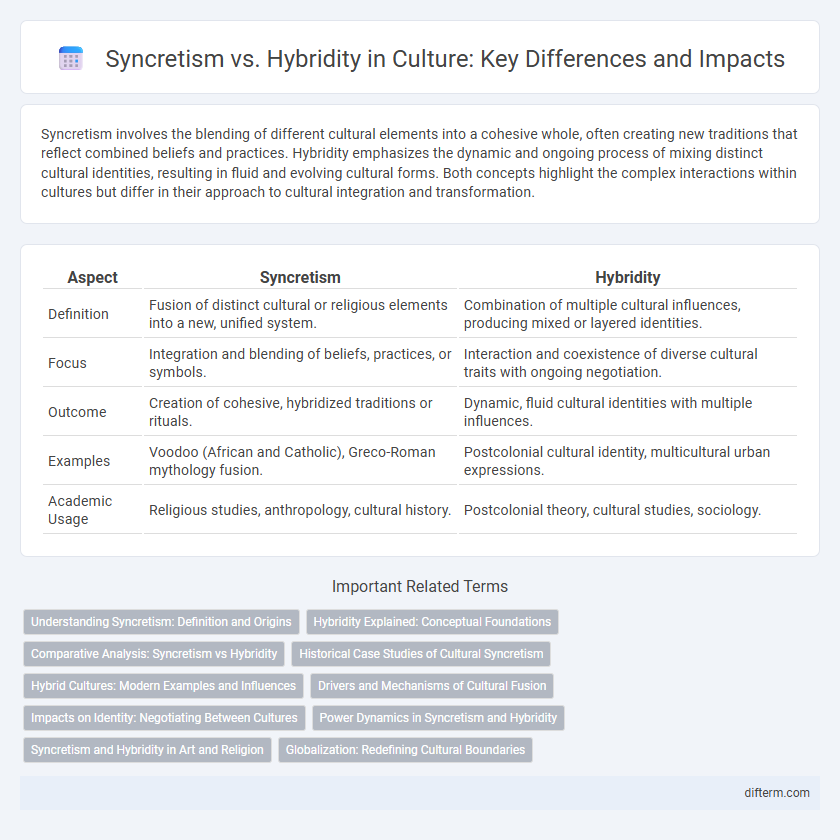Syncretism involves the blending of different cultural elements into a cohesive whole, often creating new traditions that reflect combined beliefs and practices. Hybridity emphasizes the dynamic and ongoing process of mixing distinct cultural identities, resulting in fluid and evolving cultural forms. Both concepts highlight the complex interactions within cultures but differ in their approach to cultural integration and transformation.
Table of Comparison
| Aspect | Syncretism | Hybridity |
|---|---|---|
| Definition | Fusion of distinct cultural or religious elements into a new, unified system. | Combination of multiple cultural influences, producing mixed or layered identities. |
| Focus | Integration and blending of beliefs, practices, or symbols. | Interaction and coexistence of diverse cultural traits with ongoing negotiation. |
| Outcome | Creation of cohesive, hybridized traditions or rituals. | Dynamic, fluid cultural identities with multiple influences. |
| Examples | Voodoo (African and Catholic), Greco-Roman mythology fusion. | Postcolonial cultural identity, multicultural urban expressions. |
| Academic Usage | Religious studies, anthropology, cultural history. | Postcolonial theory, cultural studies, sociology. |
Understanding Syncretism: Definition and Origins
Syncretism refers to the process through which different cultural, religious, or philosophical traditions merge to form a new, cohesive system, often observed in historical interactions like Hellenistic religions and Afro-Caribbean spiritual practices. Originating from the Greek word "synkretismos," meaning the union of Cretans, syncretism emphasizes blending and reconciliation between distinct belief systems to resolve conflicts and create shared meanings. This concept contrasts with hybridity, which highlights the dynamic, ongoing interaction and negotiation of cultural identities rather than a fixed amalgamation.
Hybridity Explained: Conceptual Foundations
Hybridity in cultural studies refers to the dynamic process through which elements from diverse cultural traditions merge to form new, distinct identities and practices, emphasizing interaction and transformation rather than mere coexistence. Rooted in postcolonial theory, hybridity challenges fixed notions of culture by highlighting fluidity, negotiation, and the creation of novel meanings within overlapping cultural frameworks. This concept contrasts with syncretism by focusing more on boundary-crossing and the agency of marginalized groups in shaping evolving cultural expressions.
Comparative Analysis: Syncretism vs Hybridity
Syncretism involves the merging of distinct cultural or religious traditions into a cohesive system, emphasizing integration and harmony between differing elements. Hybridity denotes the creation of new, distinct cultural identities through the blending and interaction of multiple cultural influences, often highlighting ongoing negotiation and transformation. Comparative analysis reveals syncretism prioritizes fusion and synthesis, while hybridity foregrounds multiplicity, fluidity, and the dynamic process of cultural identity formation.
Historical Case Studies of Cultural Syncretism
Historical case studies of cultural syncretism reveal how societies blend religious, linguistic, and social practices to create new, cohesive identities. Examples include the fusion of indigenous beliefs with Catholicism in Latin America during colonization, which produced unique spiritual rituals and iconographies. These syncretic processes challenge rigid cultural boundaries by demonstrating dynamic, negotiated exchanges rather than mere cultural hybridization.
Hybrid Cultures: Modern Examples and Influences
Hybrid cultures emerge from the blending of diverse cultural elements, creating innovative social practices and artistic expressions visible in global cities like New York, London, and Tokyo. These cultures reflect dynamic interactions where technology, migration, and media converge, influencing fashion, language, cuisine, and music, as seen in K-pop's fusion of Western and Korean styles or street art combining traditional motifs with contemporary themes. The resulting hybrid identities challenge rigid cultural boundaries, promoting inclusivity and new forms of creativity in a rapidly globalizing world.
Drivers and Mechanisms of Cultural Fusion
Syncretism and hybridity both describe cultural fusion but differ in drivers and mechanisms. Syncretism often emerges through religious or ideological confluence, driven by colonization, migration, or globalization that blend distinct belief systems into cohesive forms. Hybridity arises from everyday social interactions and power negotiations, enabling continuous, dynamic mixing of cultural practices, identities, and expressions without complete assimilation.
Impacts on Identity: Negotiating Between Cultures
Syncretism shapes identity by merging distinct cultural elements into a cohesive new tradition, often preserving continuity while fostering inclusivity. Hybridity emphasizes dynamic identity formation through ongoing cultural interaction, highlighting fluid and multifaceted self-expressions. Both processes impact how individuals and communities negotiate belonging, challenge fixed boundaries, and redefine cultural authenticity in globalized contexts.
Power Dynamics in Syncretism and Hybridity
Syncretism often involves unequal power dynamics where dominant cultures impose their beliefs, resulting in the selective blending of practices that favor the dominant group. Hybridity challenges these hierarchies by enabling marginalized cultures to actively negotiate and transform cultural expressions, fostering resistance and creative agency. Both concepts reveal how power relations shape cultural identity, but hybridity emphasizes fluidity and contestation rather than assimilation.
Syncretism and Hybridity in Art and Religion
Syncretism in art and religion involves the blending of distinct cultural elements to create a unified system that harmonizes different traditions and beliefs. Hybridity emphasizes the coexistence and interaction of diverse cultural identities, producing works that reflect multiple influences without fully merging them. Both concepts reveal dynamic processes of cultural exchange and adaptation, shaping how communities express spirituality and creativity.
Globalization: Redefining Cultural Boundaries
Globalization accelerates cultural syncretism by merging diverse traditions into blended practices, fostering shared identities across borders. Hybridity emphasizes the dynamic and ongoing process of cultural exchange, where distinct elements interact without dissolving original identities. This fluid interaction redefines cultural boundaries, highlighting interconnectedness while resisting homogenization.
syncretism vs hybridity Infographic

 difterm.com
difterm.com